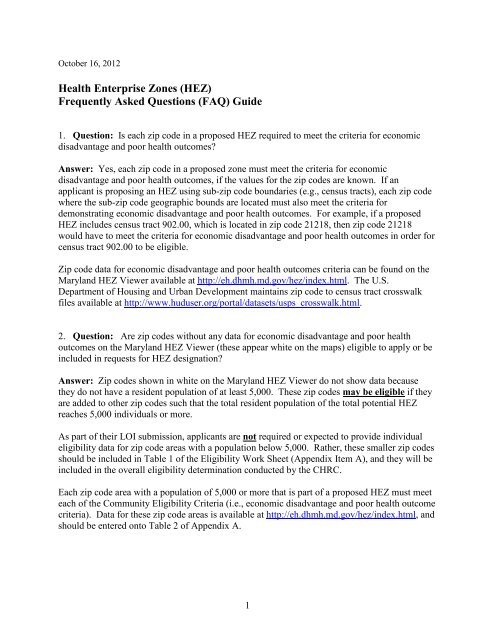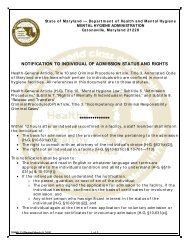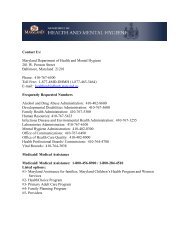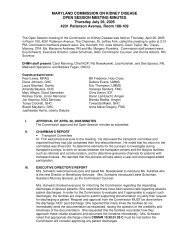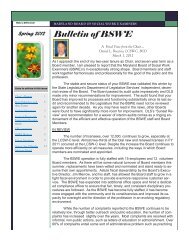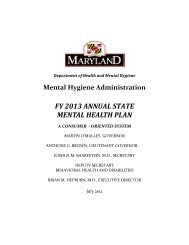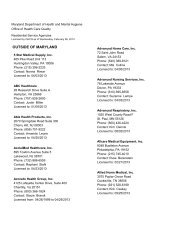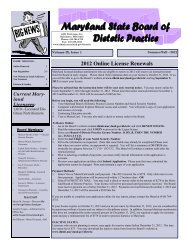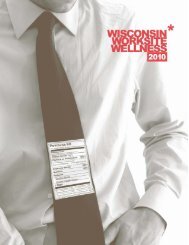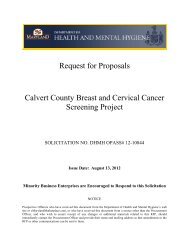Health Enterprise Zones (HEZ) Frequently ... - Dhmh - Maryland.gov
Health Enterprise Zones (HEZ) Frequently ... - Dhmh - Maryland.gov
Health Enterprise Zones (HEZ) Frequently ... - Dhmh - Maryland.gov
Create successful ePaper yourself
Turn your PDF publications into a flip-book with our unique Google optimized e-Paper software.
October 16, 2012<br />
<strong>Health</strong> <strong>Enterprise</strong> <strong>Zones</strong> (<strong>HEZ</strong>)<br />
<strong>Frequently</strong> Asked Questions (FAQ) Guide<br />
1. Question: Is each zip code in a proposed <strong>HEZ</strong> required to meet the criteria for economic<br />
disadvantage and poor health outcomes?<br />
Answer: Yes, each zip code in a proposed zone must meet the criteria for economic<br />
disadvantage and poor health outcomes, if the values for the zip codes are known. If an<br />
applicant is proposing an <strong>HEZ</strong> using sub-zip code boundaries (e.g., census tracts), each zip code<br />
where the sub-zip code geographic bounds are located must also meet the criteria for<br />
demonstrating economic disadvantage and poor health outcomes. For example, if a proposed<br />
<strong>HEZ</strong> includes census tract 902.00, which is located in zip code 21218, then zip code 21218<br />
would have to meet the criteria for economic disadvantage and poor health outcomes in order for<br />
census tract 902.00 to be eligible.<br />
Zip code data for economic disadvantage and poor health outcomes criteria can be found on the<br />
<strong>Maryland</strong> <strong>HEZ</strong> Viewer available at http://eh.dhmh.md.<strong>gov</strong>/hez/index.html. The U.S.<br />
Department of Housing and Urban Development maintains zip code to census tract crosswalk<br />
files available at http://www.huduser.org/portal/datasets/usps_crosswalk.html.<br />
2. Question: Are zip codes without any data for economic disadvantage and poor health<br />
outcomes on the <strong>Maryland</strong> <strong>HEZ</strong> Viewer (these appear white on the maps) eligible to apply or be<br />
included in requests for <strong>HEZ</strong> designation?<br />
Answer: Zip codes shown in white on the <strong>Maryland</strong> <strong>HEZ</strong> Viewer do not show data because<br />
they do not have a resident population of at least 5,000. These zip codes may be eligible if they<br />
are added to other zip codes such that the total resident population of the total potential <strong>HEZ</strong><br />
reaches 5,000 individuals or more.<br />
As part of their LOI submission, applicants are not required or expected to provide individual<br />
eligibility data for zip code areas with a population below 5,000. Rather, these smaller zip codes<br />
should be included in Table 1 of the Eligibility Work Sheet (Appendix Item A), and they will be<br />
included in the overall eligibility determination conducted by the CHRC.<br />
Each zip code area with a population of 5,000 or more that is part of a proposed <strong>HEZ</strong> must meet<br />
each of the Community Eligibility Criteria (i.e., economic disadvantage and poor health outcome<br />
criteria). Data for these zip code areas is available at http://eh.dhmh.md.<strong>gov</strong>/hez/index.html, and<br />
should be entered onto Table 2 of Appendix A.<br />
1
3. Question: Does each zip code within a proposed <strong>HEZ</strong> need to have a minimum population<br />
of 5,000, or does the total population of the proposed <strong>HEZ</strong> (the sum of all zip code populations)<br />
have to be at least 5,000?<br />
Answer: The overall resident population in a proposed <strong>HEZ</strong> must total 5,000 individuals or<br />
more. If a proposed <strong>HEZ</strong> is comprised of multiple zip code areas, it is not a requirement that<br />
each zip code area have a population of 5,000 or more. All zip codes or other geographic<br />
boundaries included in a proposed <strong>HEZ</strong> should be listed in Table 1 of Appendix A, regardless of<br />
population size.<br />
4. Question: The Call for Proposal indicates that a proposed <strong>HEZ</strong> must be a “community or a<br />
cluster of contiguous communities.” Explain or clarify what is meant by contiguous.<br />
Answer: Contiguous means that a proposed <strong>HEZ</strong> is one unbroken geographic area. If the<br />
proposed <strong>HEZ</strong> includes multiple zip codes (or other type of geographic area, e.g., census tracts),<br />
the boundaries of the zip codes must be adjacent to one another.<br />
5. Question: What flexibility exists for <strong>HEZ</strong> applicants in terms of requesting a Zone that is<br />
not geographically contiguous?<br />
Answer: The Call for Proposals states that <strong>HEZ</strong> applicants must request an <strong>HEZ</strong> designation for<br />
an area/zone that is geographically contiguous. The CHRC will receive requests for exceptions<br />
to this requirement and evaluate these requests on a case-by-case basis. Applicants will be<br />
required to demonstrate a clear and compelling argument for waiving this requirement.<br />
Considerations will include such factors as the proximity of the zip codes, the reason for not<br />
including the intervening zip code or codes, and the connections between communities.<br />
Requests for exceptions should be provided to the CHRC at the time of the submission of the<br />
Letters of Interest, which are accepted on a rolling basis but no later than October 19. Approval<br />
or denial of the requests for exceptions will be determined within two working days.<br />
6. Question: Where do applicants find or access the data necessary to determine if zip codes<br />
meet threshold eligibility requirements when preparing the Letter of Interest (LOI)?<br />
Answer: All of the data that an applicant would need when preparing the LOI submission is<br />
available on the DHMH <strong>HEZ</strong> website<br />
(http://dhmh.maryland.<strong>gov</strong>/healthenterprisezones/SitePages/Updates.aspx). On the “Updates”<br />
tab, applicants may determine the eligibility of each zip code based on economic criteria<br />
(Medicaid or WIC enrollment) and health status criteria (life expectancy or low birth weight<br />
rates).<br />
• Zip codes that are colored red on these maps are eligible.<br />
• Zip codes that are colored yellow are not eligible.<br />
• Zip codes that are colored white are below a population of 5,000, but DHMH is able to<br />
provide data for eligibility considerations upon request. Simply email<br />
2
dhmh.hez@maryland.<strong>gov</strong> to request data for zip codes that are white on these maps (below a<br />
population of 5,000).<br />
7. Question: Where can I find data to support my application in addition to the basic threshold<br />
eligibility criteria or metrics (which are currently accessible on the <strong>HEZ</strong> website)?<br />
Answer: There are many sources of additional information about geographical areas in<br />
<strong>Maryland</strong>. These include federal data sources (such as the Census Bureau, the Centers for<br />
Disease Control and Prevention, and the <strong>Health</strong> Resources and Services Administration) and<br />
state data sources in addition to local sources accessible to <strong>HEZ</strong> applicants. State data sources<br />
include the <strong>Maryland</strong> health maps website http://dhmh.maryland.<strong>gov</strong>/maps/SitePages/Home.aspx<br />
and the <strong>Maryland</strong> state mapping portal http://www.imap.maryland.<strong>gov</strong>/Portal/applications.asp.<br />
As additional resources are identified, links will be added to the <strong>HEZ</strong> Supplemental Data and<br />
Resources page at<br />
http://dhmh.maryland.<strong>gov</strong>/healthenterprisezones/SitePages/<strong>HEZ</strong>_Resources.aspx.<br />
8. Question: How can potential applicants, organizations, and interested community members<br />
connect with others to apply for <strong>HEZ</strong> status? Will the state be providing any assistance in<br />
convening or coordinating local groups?<br />
Answer: Letters of Interest (LOIs) will be accepted on a rolling basis, but are due to the CHRC<br />
no later than 5:00 p.m., Friday, October 19. The CHRC will certify eligibility within a 48-hour<br />
period of receipt of the LOI, notify applicants of their eligibility, and post each certified LOI on<br />
the <strong>HEZ</strong> website. Contact information for each certified LOI will be provided. Applicants who<br />
submit the LOI on Thursday, October 18 or Friday, October, 19 will be notified of their<br />
eligibility in the first few days of the following week (Monday, October 22 and Tuesday,<br />
October 23). In addition, potential <strong>HEZ</strong> applicants are encouraged to coordinate <strong>HEZ</strong><br />
applications with the relevant Local <strong>Health</strong> Improvement Coalitions to involve local partners in<br />
the <strong>HEZ</strong> application.<br />
Contacts for the Local <strong>Health</strong> Improvement Coalitions are available on the <strong>HEZ</strong> website, under<br />
“<strong>HEZ</strong> Supplemental Data and Resources” at<br />
http://dhmh.maryland.<strong>gov</strong>/healthenterprisezones/SitePages/Hez_Resources.aspx.<br />
9. Question: Are non-profit hospitals eligible to apply for an <strong>HEZ</strong> designation?<br />
Answer: Yes, non-profit hospitals or other community-based non-profit organizations are<br />
eligible to serve as the lead Coordinating Organization that submits the <strong>HEZ</strong> application.<br />
3
10. Question: Are for-profit entities eligible for grant funding?<br />
Answer: Yes, for-profit entities are eligible to receive grant funding (via the Coordinating<br />
Organization) under the Act.<br />
11. Question: Can cancer be one of the disparities/targeted conditions included in an <strong>HEZ</strong><br />
proposal?<br />
Answer: Yes, cancer or other conditions or diseases may be targeted for improvement in an<br />
<strong>HEZ</strong> proposal. Conditions or diseases targeted should be based on identified community needs<br />
and/or disparities.<br />
12. Question: Are any diseases or conditions given priority or preference if targeted in an <strong>HEZ</strong><br />
application? For instance, the Call for Proposal encourages applicants to target at least one of<br />
the following: cardiovascular disease, diabetes, or asthma. Will applicants that target one or<br />
more of these be given preference for <strong>HEZ</strong> designation?<br />
Answer: Applicants should target conditions for which substantial disparities exist within<br />
<strong>Maryland</strong>. Such disparities exist for these chronic diseases. If other targets are chosen, a strong<br />
case should be made about the nature of the disparity being addressed.<br />
13. Question: What types and levels of practitioners are eligible to receive incentives and<br />
benefits under the <strong>HEZ</strong> Initiative? Can other health care providers, specialty physicians, or<br />
non-clinical members of a care team be considered part of the primary care workforce?<br />
Answer: As defined by the <strong>HEZ</strong> Act, a “<strong>Health</strong> <strong>Enterprise</strong> Zone Practitioner” is one who is<br />
licensed or certified under the <strong>Health</strong> Occupations Article of the <strong>Maryland</strong> Annotated Code and<br />
who provides:<br />
• Primary care (including obstetrics, gynecological, pediatric, or geriatric services),<br />
• Behavioral health services (including mental health or alcohol and substance abuse<br />
services), or<br />
• Dental services.<br />
The goal of the <strong>HEZ</strong> Initiative is to increase access to primary care services within the Zone<br />
through a range of incentives and benefits. These incentives and benefits are available to<br />
eligible providers/individual practitioners, and are not limited to physicians. Other health care<br />
personnel such as nurse practitioners, physician assistants, registered nurses, and others are<br />
eligible to receive these incentives and benefits.<br />
4
14. Question: How can a practitioner or practice qualify for tax credits?<br />
Answer: A practitioner can receive tax credits in accordance with an approved <strong>HEZ</strong> plan. For<br />
example, if an <strong>HEZ</strong> application includes a certain amount of money set aside for tax credits for<br />
primary care physicians and nurse practitioners, those types of practitioners would be eligible for<br />
a tax credit.<br />
Other requirements in legislation for practitioners to receive the tax credit include:<br />
• demonstration of competency in cultural, linguistic, and health literacy in the form<br />
determined by the Department;<br />
• acceptance and provision of care for patients enrolled in the <strong>Maryland</strong> Medical<br />
Assistance Program and uninsured patients; and<br />
• meeting the other requirements in the legislation and regulation.<br />
Regulations will be proposed later this fall that specify in greater detail the requirements<br />
practitioners must meet to be eligible for tax credits and that specify the procedures for<br />
certification of tax credits.<br />
15. Question: What constitutes a “qualified position” under hiring tax credit incentives?<br />
Answer: A “qualified position” is an <strong>HEZ</strong> practitioner, community health worker, or interpreter.<br />
The position must meet the following criteria:<br />
a. Provides direct support to an <strong>HEZ</strong> practitioner;<br />
b. Expands access to services in an <strong>HEZ</strong>;<br />
c. Pays at least 150% of the federal minimum wage;<br />
d. Is full time and of indefinite duration;<br />
e. Is located in the <strong>HEZ</strong>; and<br />
f. Is newly created as a result of the establishment of, or services in, an <strong>HEZ</strong>.<br />
16. Question: Are hiring tax credits one-time credits when the “qualified position” is hired?<br />
Answer: The hiring tax credits, at a potential value of $10,000 per employee, are one-time, but<br />
are spread out over two years. The hired “qualified position” has to stay in the <strong>HEZ</strong> for two<br />
years; otherwise there is a clawback of the credit.<br />
17. Question: Do practitioners need to reside and provide services in the <strong>HEZ</strong> to be eligible for<br />
incentives and benefits?<br />
Answer: A practitioner is not required to reside in an <strong>HEZ</strong>, but is required to provide services in<br />
an <strong>HEZ</strong> to be eligible for incentives and benefits.<br />
5
18. Question: Is there a data source that can be used to estimate or calculate the <strong>HEZ</strong><br />
incentives? Specifically, is there guidance on how to (1) calculate state income tax credits, (2)<br />
determine the level of loan repayment assistance, and (3) estimate any cost benefits from<br />
participation in the state's Patient Centered Medical Home Program?<br />
Answer: Regarding the calculation of individual income tax credits, this will be based on two<br />
factors: (1) the number of practitioners proposed to receive the credit against their state income;<br />
and (2) the annual taxable income of the individual practitioner. Practitioners approved by the<br />
<strong>HEZ</strong> Coordinating Organization may claim a credit against the state income tax in an amount<br />
equal to 100% of the amount of the state income tax expected to be due from the <strong>HEZ</strong><br />
practitioner from income derived from the practice in the <strong>HEZ</strong> as certified by DHMH in that<br />
taxable year.<br />
In addition to the state income tax credit, a practitioner approved by the <strong>HEZ</strong> Coordinating<br />
Organization may claim a refundable credit of $10,000 against the state income tax for hiring a<br />
qualified position in the <strong>HEZ</strong>, again, as certified by DHMH in that taxable year. Practitioners<br />
must practice in the <strong>HEZ</strong> for at least two years.<br />
Estimated costs for participation in the state’s PCMH program will vary based on the individual<br />
practice. The <strong>Maryland</strong> <strong>Health</strong> Care Commission (MHCC), which is implementing the PCMH<br />
Program, has estimated that these costs might reflect the cost of submitting an application for<br />
NCQA recognition, which includes an $80 application fee and $500 for each physician in the<br />
practice.<br />
19. Question: Are there any incentives that must be included in an <strong>HEZ</strong> application?<br />
Answer: <strong>HEZ</strong> applicants must include in their <strong>HEZ</strong> application a proposal to use loan<br />
repayment incentives to attract <strong>HEZ</strong> practitioners to an <strong>HEZ</strong>. While there are no specific<br />
budgetary caps for loan repayment, this is the only incentive that must be included in an <strong>HEZ</strong><br />
application. The other incentives – income tax credit, hiring tax credit, capital grant assistance –<br />
are optional. As part of that proposal, the Coordinating Organization should include eligibility<br />
requirements for loan repayment assistance, which are subject to approval by the Secretary and<br />
the CHRC.<br />
20. Question: What are the requirements for individual practitioners to receive loan repayment<br />
assistance? Does a practitioner have to practice in a <strong>Health</strong> Professional Shortage Area (HPSA)<br />
to be eligible to receive loan repayment assistance under the <strong>HEZ</strong> Initiative?<br />
Answer: <strong>HEZ</strong> Coordinating Organizations are expected to develop these criteria as part of their<br />
application. Applicants are encouraged to consult the guidelines for existing loan repayment<br />
programs. The Janet L. Hoffman Loan Assistance Repayment Program (LARP) can be accessed<br />
at http://www.mhec.state.md.us/financialaid/ProgramDescriptions/prog_larp.asp. Information<br />
pertaining to the State Loan Repayment Program (SLRP) can be accessed at<br />
http://fha.dhmh.maryland.<strong>gov</strong>/ohpp/SitePages/pco-larp.aspx.<br />
6
Practitioners do not have to practice in an HPSA to receive loan repayment assistance, but they<br />
must practice in a designated <strong>HEZ</strong> and meet any requirements developed by the <strong>HEZ</strong><br />
Coordinating Organization.<br />
21. Question: Is a practitioner who provides services on a part-time basis eligible for loan<br />
repayment?<br />
Answer: Practitioners who provide services on a part-time basis in the Zone, such as one or two<br />
days a week, may be eligible to receive loan repayment assistance if they meet the criteria<br />
established by the <strong>HEZ</strong> Coordinating Organization. This benefit should be provided on a<br />
commensurate basis based on the number of hours or days worked. For example, if a full time<br />
employee (FTE) is eligible for a total $25,000 tuition loan repayment, then a person who works<br />
one day per week would be eligible for $5,000.<br />
22. Question: Do practitioners have to practice at a particular type of facility?<br />
Answer: No. There are no facility-specific requirements other than the requirement that the<br />
services be provided within the Zone.<br />
23. Question: Are CHRC grant resources available for residents living in a designated <strong>HEZ</strong>?<br />
Answer: Grant programs that provide resources to residents are permissible provided the<br />
program will help to achieve goals of the <strong>HEZ</strong> Initiative. These grant resources are part of the<br />
$4 million annual budget for the <strong>HEZ</strong> Initiative; they are not in addition to this $4 million. As<br />
part of the <strong>HEZ</strong> Call for Proposals, applicants are encouraged to submit an annual budget request<br />
between $500,000 to $2 million per year for the duration of the four-year program. Grant<br />
resources or incentives for residents living within the designated <strong>HEZ</strong> should be part of this<br />
budget request (they are not in addition to the budget request).<br />
24. Question: Can CHRC grant funding be used to pay tuition?<br />
Answer: Yes. Covering the costs of tuition may be included/covered in a grant request from the<br />
CHRC and, like other CHRC grant requests, would need to be included in the overall/global<br />
budget of the <strong>HEZ</strong> application.<br />
25. Question: Can grant funding from the CHRC be utilized to support transportation services?<br />
Answer: Yes, grant funding can be used to cover the costs of client or patient transportation<br />
services such that these services expand access to health care services for target resident<br />
populations within the Zone. The need for transportation services should be documented and<br />
part of an overall strategy(ies) to achieve the program’s goals. One of the fundamental<br />
7
objectives of the <strong>HEZ</strong> Initiative is to create sustainable assets and programs that remain in an<br />
<strong>HEZ</strong> after the program has ended.<br />
26. Question: In addition to grant resources available under the <strong>HEZ</strong> Initiative, are there other<br />
incentives or existing resources to support adoption of electronic health records (EHR)?<br />
Answer: Yes, there are two additional resources available for providers interested in adopting<br />
electronic health records. The State-regulated Payor EHR Adoption Incentive provides up to<br />
$15,000 per primary care practice that adopts an EHR system. Practices must meet certain<br />
conditions for payment and do business with one of the following state-regulated/commercial<br />
payors: Aetna, CareFirst BlueCross BlueShield, Cigna <strong>Health</strong>Care Mid-Atlantic, Coventry<br />
<strong>Health</strong> Care, Kaiser Permanente, and United <strong>Health</strong>care, Mid Atlantic Region. The following<br />
link provides more information regarding this program: State-Regulated EHR Adoption<br />
Incentives.<br />
Under the federal Medicare and Medicaid EHR incentive programs, eligible providers can<br />
receive up to $44,000 over five years through the Medicare incentive program, or as much as<br />
$63,750 over six years in the Medicaid incentive program. The following link provides more<br />
information regarding this program: Federal EHR Adoption Incentives.<br />
27. Question: What is the duration of the <strong>HEZ</strong> Initiative?<br />
Answer: The <strong>HEZ</strong> Initiative is a four-year pilot program that will designate <strong>Zones</strong> for a fouryear<br />
period, based on calendar years (2013, 2014, 2015, and 2016). Applicants should submit an<br />
annual budget and work plan for each of the four calendar years of the program.<br />
28. Question: Will the same <strong>HEZ</strong>s be funded each year for the four-year pilot program, or will<br />
new zones be designated each year?<br />
Answer: <strong>HEZ</strong>s that are designated in year one (CY 2013) of the program will be funded in year<br />
one. While the designation is for a four-year period, funding in years two, three, and four will be<br />
contingent on the availability of state funds and the compliance/performance of the <strong>HEZ</strong><br />
Coordinating Organization.<br />
29. Question: Are Coordinating Organizations permitted to make adjustments to the <strong>HEZ</strong><br />
program budgets in the out years (years two through four)?<br />
Answer: Yes, Coordinating Organizations will be permitted to make adjustment to their budgets<br />
in years two-four through a formal process with the CHRC. Post-designation, successful <strong>HEZ</strong><br />
applicants will negotiate the first year budget with the DHMH Secretary and CHRC in January<br />
2013.<br />
8
30. Question: What are the core responsibilities of the <strong>HEZ</strong> Coordinating Organization? What<br />
is the Coordinating Organization permitted to include in indirect or administrative costs?<br />
Answer: The <strong>HEZ</strong> Coordinating Organization, the lead <strong>HEZ</strong> applicant, is responsible for<br />
developing the overall work plan of activities to expand access within the <strong>HEZ</strong>; selecting the<br />
incentives, benefits, and strategies that will be utilized within the <strong>HEZ</strong>; serving as the sole fiscal<br />
agent administering these benefits and incentives to individual practices and practitioners within<br />
the <strong>HEZ</strong>; and developing the global budget that reflects the benefits and incentives that will be<br />
utilized. To execute these activities, the Coordinating Organization is permitted to charge 10%<br />
in indirect costs, which should be included in the global budget. For example, if the sum of all<br />
benefits and incentives is $500,000, the Coordinating Organization is permitted to charge 10% of<br />
$500,000, or $50,000. The indirect costs of $50,000 would be included in the global budget.<br />
In addition to these indirect costs, the Coordinating Organization is encouraged to include 5%-<br />
10% of the overall global budget to cover the costs of internal evaluation activities and<br />
monitoring the performance of individual practices and practitioners receiving <strong>HEZ</strong> resources.<br />
<strong>HEZ</strong> applicants are encouraged to limit overall indirect or administrative costs of the global<br />
budget of the <strong>HEZ</strong> application and dedicate limited <strong>HEZ</strong> resources to activities that will provide<br />
services to residents of the <strong>HEZ</strong>. The DHMH Secretary and CHRC will have the authority to<br />
make adjustments (such as reducing the amount of indirect costs charged to the program) to the<br />
<strong>HEZ</strong> global budget request after the Zone is designated.<br />
31. Question: Are <strong>HEZ</strong> applicants permitted or encouraged to include costs for “data collection<br />
and evaluation” in their global budget?<br />
Answer: As described on page 17 of the Call for Proposals, applicants are encouraged to<br />
include between 5%-10% of the overall <strong>HEZ</strong> global budget for data collection and evaluation<br />
efforts. For example, if the global budget is $500,000 in year one, the budget for Data Collection<br />
and Evaluation should be between $25,000 and $50,000.<br />
32. Question: In the Call for Proposals, under Review Principle #9, what is meant by<br />
“<strong>gov</strong>ernance structure” and “accountability”?<br />
Answer: “Governance structure” refers to the structure and membership of the Coordinating<br />
Organization, participating partners, and any other members of the coalition in the Zone. <strong>HEZ</strong><br />
applicants may organize the coalition and/or advisory groups into a coordinating board or<br />
committee and establish a <strong>gov</strong>ernance structure for the group. Evidence of a <strong>gov</strong>ernance<br />
structure could include the adoption of By-laws, which includes policies, procedures, and various<br />
roles and responsibilities of organizations. Governance structure may be displayed on an<br />
organizational chart.<br />
“Accountability” refers to who (specifically) within the Coordinating Organization is ultimately<br />
responsible for ensuring the performance of the activities in the Zone. Accountability may relate<br />
to the internal evaluation activities performed by the Coordinating Organization to monitor the<br />
9
performance of participating partners in the Zone. Finally, accountability refers to how the<br />
Coordinating Organization will hold participating partners and other recipients of <strong>HEZ</strong> benefits<br />
and incentives accountable for performance.<br />
33. Question: Will <strong>HEZ</strong> Coordinating Organizations be encouraged to include meaningful and<br />
active participation of residents living in the zone in the development and implementation of the<br />
<strong>HEZ</strong> plan and strategies?<br />
Answer: <strong>HEZ</strong> applicants are strongly encouraged to include the active and meaningful<br />
participation of residents within the Zone in the formal <strong>HEZ</strong> <strong>gov</strong>ernance structure. As part of<br />
their <strong>HEZ</strong> application, Coordinating Organizations will be required to demonstrate in their<br />
application the meaningful participation of members or residents of the target population and<br />
minority groups within the requested <strong>HEZ</strong>. Particular emphasis in the application should be<br />
devoted to describing how the resident population will be involved on an active basis in the<br />
planning and implementation of the activities within the Zone. An example of meaningful<br />
participation could be reflected in the creation/addition of a Community Advisory Board<br />
comprised of residents within the designated Zone as a member of the coalition of partners in the<br />
Zone.<br />
34. Question: How will the community be involved in the evaluation of the <strong>HEZ</strong> Initiative and<br />
measuring the impact of the program on residents in the <strong>HEZ</strong>?<br />
Answer: <strong>HEZ</strong> Coordinating Organizations will be required to demonstrate in their application<br />
meaningful participation of resident populations served by the Zone in the evaluation activities<br />
as part of the regular reporting to the CHRC. An <strong>HEZ</strong> application should include a clear process<br />
for executing an internal evaluation plan which will enable the <strong>HEZ</strong> Coordinating Organization<br />
to monitor the performance of participating partners and implementation strategies within the<br />
Zone. As part of this internal evaluation plan, the Coordinating Organization may wish to<br />
establish an advisory group to guide/inform this evaluation plan and ensure the participation of<br />
residents within the Zone in the evaluation plan. Examples of facilitating the participation of<br />
residents in this evaluation plan could include surveys and focus groups (the results of these<br />
activities would be included/highlighted in the evaluation plan).<br />
35. Question: Will the state be providing any technical assistance to the <strong>HEZ</strong>s once these zones<br />
are designated?<br />
Answer: Technical assistance through the state or other entities will be made available to <strong>Zones</strong><br />
on a requested, case-by-case basis. Coordinating Organizations should make technical assistance<br />
requests to the CHRC which will be forwarded to the appropriate experts in the CHRC and<br />
DHMH.<br />
10
36. Question: Will the state offer any assistance to applicants who submit a proposal but are not<br />
designated as an <strong>HEZ</strong>?<br />
Answer: Requests that are not successful will be evaluated on a case-by-case basis, and the<br />
State will determine what other resources may be available to institute some or all of the <strong>HEZ</strong>.<br />
37. Question: What is meant by long-term financial sustainability? Can examples be provided?<br />
Answer: Long-term financial sustainability refers to how the <strong>HEZ</strong> Coordinating Organization<br />
and participating partners will ensure that programs initiated and resources added to a zone will<br />
be maintained after the four-year program period ends. For example, an organization that begins<br />
new services under <strong>HEZ</strong> grant program funding should work to obtain reimbursements for these<br />
services from third-party insurance plans.<br />
38. Question: In the proposal review process, will some sections be weighted more heavily than<br />
others? If so, please provide insight into how each section will be weighed.<br />
Answer: As indicated in the Joint Chairmen’s Report and public presentations, the review of<br />
<strong>HEZ</strong> applications will be based on 13 review principles which are based on the <strong>HEZ</strong> Act.<br />
<strong>HEZ</strong> Applications will be reviewed on these 13 criteria, and each application will receive a<br />
numeric score based on a 100-point scale. The following are the 13 criteria and the potential<br />
total point value for each principle:<br />
Possible Points<br />
Item 100 point scale<br />
1 Purpose 5<br />
2 Description of need 10<br />
3 Core disease targets and conditions 5<br />
4 Goals 10<br />
5 Strategies 10<br />
6 Cultural, linguistic and health literacy competency 7.5<br />
7 Balance 5<br />
8 Contributions from local partners 5<br />
9 Coalition 5<br />
10 Work-plan 10<br />
11 Program management and guidance 10<br />
12 Sustainability 7.5<br />
13 Internal evaluation and progress monitoring 10<br />
Total Possible Points 100<br />
11


